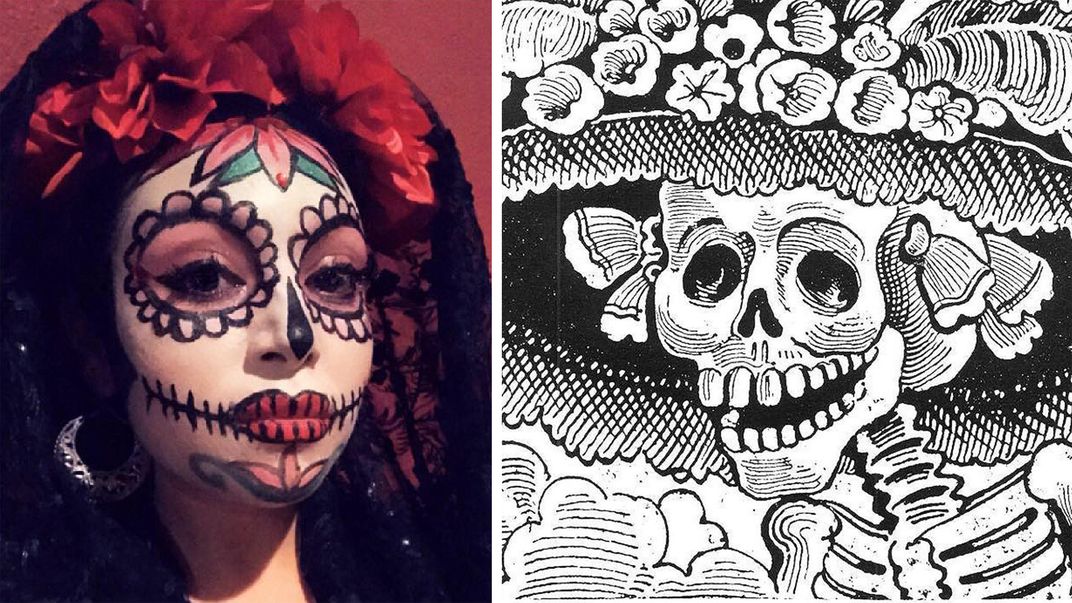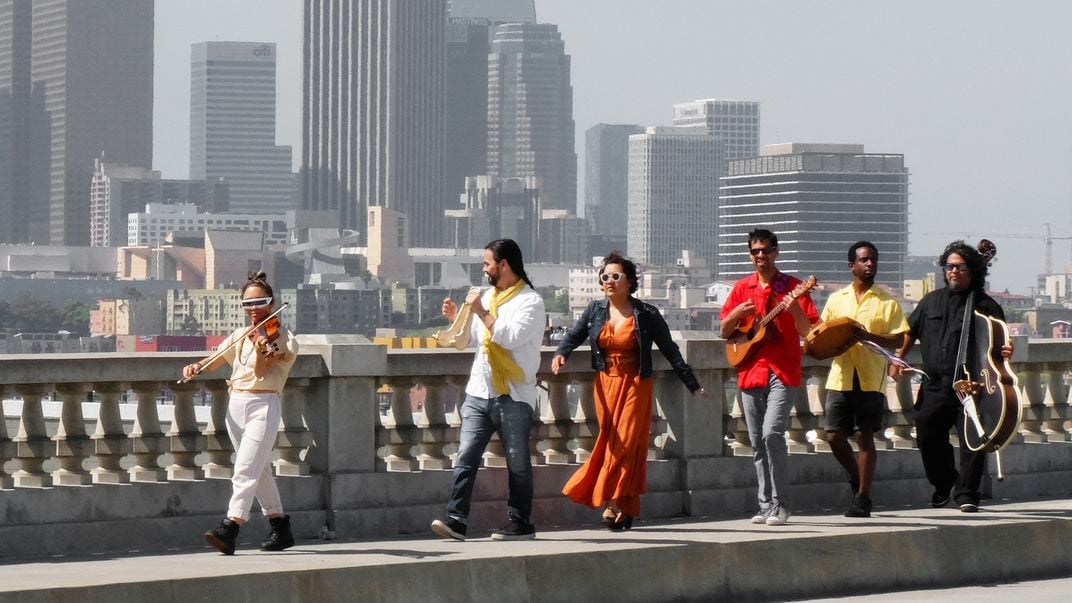NATIONAL MUSEUM OF THE AMERICAN INDIAN
Celebrate the Day of the Dead from Home with Music, Butterfly Science, Cultural Presentations, and Family Activities
Join us to celebrate the Day of the Dead virtually with cultural and environmental presentations, music, and art online. Share memories of your loved ones on the museum’s Facebook page. The roots of el Día de los Muertos are millennia-deep in Indigenous Mexico. Today, the holiday is celebrated in cities and towns throughout the United States and, increasingly, around the world. In addition to giving an overview of the observance and a look at the virtual programs being offered by the museum this weekend, Dennis Zotigh provides links to online resources, including family activities and good books for young readers.
/https://tf-cmsv2-smithsonianmag-media.s3.amazonaws.com/blogging/featured/Ofelia_Esparza_Sacred_Origins.jpg)
“In its most basic sense, the Day of the Dead is an act of remembrance. It serves a human need to be connected with our departed loved ones.”
—Cynthia Vidaurri, National Museum of the American Indian
El Día de los Muertos, or the Day of the Dead, a traditional commemoration in communities throughout Mexico, has become holiday for many people in the United States and around the world, observed October 31 through November 2. Join us online this weekend as the National Museum of the American Indian celebrates the holiday virtually with programs Friday evening and Saturday and Sunday afternoon.
On the Day of the Dead (el Día de los Muertos), families remember and celebrate those who have passed on from this world to the next, welcoming the return of the souls of their deceased relatives with rituals that include offerings, food, and drink. The Day of the Dead has been associated with rituals dedicated to the Mexica (Aztec) goddess of the underworld, Mictecacíhuatl. Olmec, Maya, and Toltec peoples also honored their dead, burying them with offerings, as well as food and water to help them on their journey to the next world, and observing special months of the year when they believed that the deceased would return.
In the early 1900s, the social critic and cartoonist José Guadalupe Posada (1852–1913) transformed Mictecacíhuatl into La Calavera Catrina, a skeleton dressed in the European fashions of Mexican high society. Posada’s caricature has become the most recognizable Day of the Dead icon, and those who celebrate often paint their faces to resemble skulls. It should be noted that the Day of the Dead is sometimes confused with being a Mexican version of Halloween, but the only cultural connection between two holidays is their association with the Christian observance of All Saints’ Day on November 1.

Today, people celebrate the Day of the Dead by leaving food, messages, and other offerings on handmade ofrendas (literally, offerings, also described as altars) within their homes, or on their loved ones’ graves. Traditionally, men and boys clean the graveyards and whitewash their families’ tombs and headstones for the holiday. Some families lay a trail of fragrant marigold petals to guide the souls of their dead from the cemetery to their homes.
The souls of the dead are believed to awaken for the holidays and to return to the living world to feast, drink, dance, and play music with their living family members. There, ofrendas decorated with candles, photographs, bright marigolds, cut paper art, sugar skulls, water, and favorite foods and drinks welcome the dead. The living traditionally enjoy dishes such as tamales, pozole, menudo, mole, tortillas, and pan de muerto, a sweet yeast bread made for the holiday.
Long observed in the more rural, Indigenous areas of Mexico, during the 1980s Day of the Dead celebrations began to become popular in cities in both Mexico and the United States. In 2008, the United Nations Educational, Scientific and Cultural Organization (UNESCO) acknowledged growing global awareness of the Day of the Dead and recognized Mexico’s “Indigenous festivity dedicated to the dead” as part of the Intangible Cultural Heritage of Humanity. As of 2016, according to the U.S. Census Bureau, more than 36 million people living in the United States identified themselves as being of partial or full Mexican ancestry.
Día de los Muertos/Day of the Dead 2020 online
Federal support for these programs is provided by the Latino Initiatives Pool, administered by the Smithsonian Latino Center.

illumiNATIONS Día de los Muertos
Friday, October 30, 6 to 7 p.m. Eastern time
Streaming on the museum’s Facebook and YouTube pages
Learn about monarch butterflies from cultural expert Tlisza Jaurique and Smithsonian scientists. Their illustrated conversation looks at monarchs’ symbolism, which dates back centuries in Indigenous Mexico, and current research that tracks the butterflies’ annual migration to Mexico and helps preserve their habitats.
Enjoy the music of GRAMMY-winning East L.A. band Quetzal.
Tour the Mesa, Arizona, studio of sculptor and mask-maker Zarco Guerrero and learn about the role masks play in Día de los Muertos celebrations. Then make your own Day of the Dead mask.
Día de los Muertos | Day of the Dead Weekend Festival
Saturday, October 31, and Sunday, November 1, from 2 to 3 pm. Eastern time
Streaming on the museum’s Facebook and YouTube pages
Celebrate Día de los Muertos from home with activities for families, beautiful art, and the rich culinary heritage of the holiday. Live on Facebook and YouTube.
Museum folklorist Cynthia Vidaurri answers frequently asked questions about Day of the Dead. What is Día de los Muertos? How is it different from Halloween? What is an ofrenda? What is the meaning of the beautiful decorations? Cynthia will share images collected over her years of research, as well as photos from past years' Day of the Dead celebrations at the museum.
Chef Neftali Duran guides a culinary journey through the foods and feasting associated with Día de los Muertos. Learn more about mole, a signature sauce associated with the celebrations, and delve into the rich history of pan de muerto.
Evelyn Orantes (Quiche Maya) and Joaquin Newman (Yaqui/Mexica) welcome people into their home in Los Angeles to share their altar and teach making paper marigolds. Recommended supplies to follow their step-by-step instructions: Colored tissue or crepe paper, cut into squares approximately 5 by 5 inches. (Each flower uses 4 to 7 squares.) Pipe cleaners or twist ties to hold the layers of petals together and be stems. Scissors.
Additional resources
Day of the Dead collections and other learning resources provided by the Smithsonian Latino Center
Day of the Dead books for young readers
Instructions and patterns for making butterfly and skull masks
You can wish someone a happy Day of the Dead by saying, “¡Feliz día de los Muertos!”
